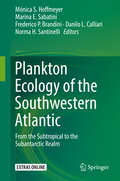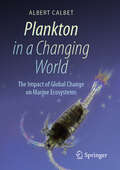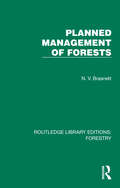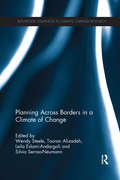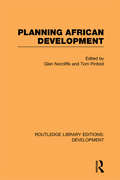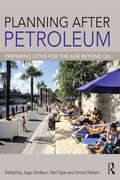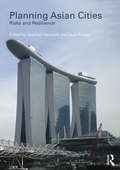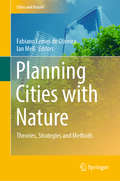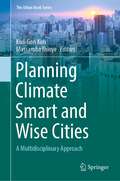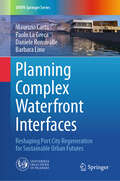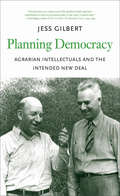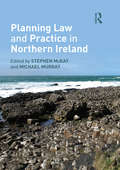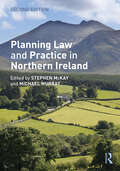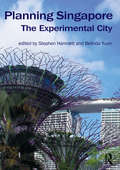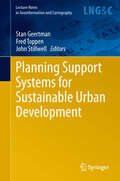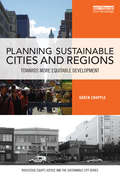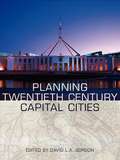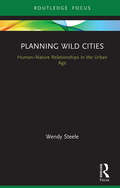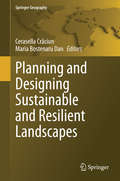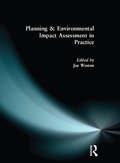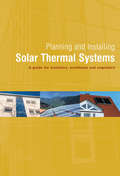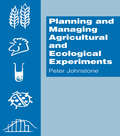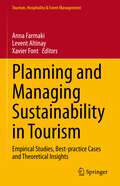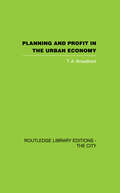- Table View
- List View
Plankton Ecology of the Southwestern Atlantic: From the Subtropical to the Subantarctic Realm
by Mónica S. Hoffmeyer Marina E. Sabatini Frederico P. Brandini Danilo L. Calliari Norma H. SantinelliThis book integrates a variety of issues such as regional settings of productivity and nutrient cycling; plankton of coastal and shelf systems; plankton, climate change and human-induced changes; harmful algae and their impacts; and gelatinous zooplankton. This book explores the intriguing marine plankton communities of the SWA region of South America encompassing low to high latitude environments, framed by a complex hydrographic background and global climate change.This vast and iconic region has been largely under-recognized and under-studied. However, in recent years a strong interest has emerged along with the acknowledgment of its high biological productivity. The book concludes by discussing conservation in the region, highlighting regional biodiversity hotspots where the challenges of climate change, habitat loss, and other threats to biodiversity may be particularly acute.Plankton Ecology of the Southwestern Atlantic is a timely synthesis of the field, setting a new baseline for future research. It will be important reading for both researchers and graduate students, and will also be of interest and use to a professional audience of oceanographers, conservation biologists, stake holders and educated science enthusiasts
Plankton in a Changing World: The Impact of Global Change on Marine Ecosystems
by Albert Calbet"Plankton in a Changing World: The Impact of Global Change on Marine Ecosystems" invites readers to explore the microscopic hidden world beneath the waves. This book unravels the fundamental concepts of plankton ecology and their relevance, while exploring the profound impacts of global environmental changes on these vital organisms. Written in a clear and engaging way for the general public, it begins with a foundational overview of plankton, allowing it to stand alone. However, reading "The Wonders of Marine Plankton," from the same author, is encouraged for a deeper understanding of plankton ecology and peculiarities. Plankton form the very foundation of marine ecosystems. As climate change, pollution, and human activities continue to reshape our world, understanding the intricate dynamics of plankton becomes increasingly crucial. This book offers a comprehensive exploration of how these changes influence plankton populations, with far-reaching consequences for marine life and global ecosystems. Addressing issues such as rising temperatures, ocean acidification, pollution, and overfishing, the book highlights the complex challenges plankton face. Regional perspectives and case studies illustrate varied responses across different climates, showcasing the diverse impacts and adaptive strategies. Through engaging prose and rich scientific insight, "Plankton in a Changing World: The Impact of Global Change on Marine Ecosystems" invites readers to appreciate the delicate balance of our ocean and the pivotal role plankton play in maintaining it. Concluding with future research directions, it underscores the need for innovative approaches and public awareness to safeguard these essential organisms. "Plankton in a Changing World: The Impact of Global Change on Marine Ecosystems" is an essential read for those interested in marine life and environmental science. Discover how tiny organisms can have a colossal impact and why their survival is intertwined with the future of our world.
Planned Management of Forests (Routledge Library Editions: Forestry)
by N. V. BrasnettOriginally published in 1953, this book was compiled to provide students of forestry with a simple outline of what the management of forests involves, and of the way in which forestry operations are organized and controlled. Topics discussed and explained include economic considerations, stock mapping, topography, climate, soils, form and distribution of crops, scientific forestry, destruction of forests, regulation by volume, area and size and forest protection.
Planning Across Borders in a Climate of Change (Routledge Advances in Climate Change Research)
by Wendy Steele Silvia Serrao-Neumann Tooran Alizadeh Leila Eslami-AndargoliThe fixity or mobility of borders are key themes within the border studies literature and have useful critical application to urban and environmental planning through theory, pedagogy and practice. This offers potential for transformative change through the processes of re-bordering and re-orienting established boundary demarcations in ways that support and promote sustainability in a climate of change. Planning Across Borders in a Climate of Change draws on a range of diverse case studies from Australasia, North and South America, Europe, Africa, the Middle East and Asia and offers the application of border theory, concepts and principles to planning as a critical lens. It applies this lens to a range of international case studies in key areas such as climate change adaptation, food security, spatial planning, critical infrastructure and urban ecology. This collection fills an important gap in the border studies literature, bringing climate change considerations to bear on planning. It should be of interest to students, scholars and professionals in the field of urban and environmental planning, climate change adaptation, border studies, urban studies, human and political geography, environmental studies and development.
Planning African Development (Routledge Library Editions: Development)
by Glen Norcliffe Tom PinfoldFirst published in 1981, this book concerns specifically the Kenyan experience with regards to development planning but, given that the problems of hunger poverty and underdevelopment manifest themselves in slightly different forms across all African countries, this book has considerable relevance to development planning across the African continent.The first set of essays in this collection address the question of development which is undoubtedly Africa’s highest development priority. The second grouping of essays considers issues in project planning and asks questions concerning cost, method, outcome and evaluation of various projects in Kenya
Planning After Petroleum: Preparing Cities for the Age Beyond Oil
by Neil Sipe Jago Dodson Anitra NelsonThe past decade has been one of the most volatile periods in global petroleum markets in living memory, and future oil supply security and price levels remain highly uncertain. This poses many questions for the professional activities of planners and urbanists because contemporary cities are highly dependent on petroleum as a transport fuel. How will oil dependent cities respond, and adapt to, the changing pattern of petroleum supplies? What key strategies should planners and policy makers implement in petroleum vulnerable cities to address the challenges of moving beyond oil? How might a shift away from petroleum provide opportunities to improve or remake cities for the economic, social and environmental imperatives of twenty-first-century sustainability? Such questions are the focus of contributors to this book with perspectives ranging across the planning challenge: overarching petroleum futures, governance, transition and climate change questions, the role of various urban transport nodes and household responses, ways of measuring oil vulnerability, and the effects on telecommunications, ports and other urban infrastructure. This comprehensive volume – with contributions from and focusing on cities in Australia, the UK, the US, France, Germany, the Netherlands and South Korea – provides key insights to enable cities to plan for the age beyond petroleum.
Planning Asian Cities: Risks and Resilience (Planning, History and Environment Series)
by Stephen Hamnett Dean ForbesIn Planning Asian Cities: Risks and Resilience, Stephen Hamnett and Dean Forbes have brought together some of the region’s most distinguished urbanists to explore the planning history and recent development of Pacific Asia’s major cities. They show how globalization, and the competition to achieve global city status, has had a profound effect on all these cities. Tokyo is an archetypal world city. Singapore, Hong Kong and Seoul have acquired world city characteristics. Taipei and Kuala Lumpur have been at the centre of expanding economies in which nationalism and global aspirations have been intertwined and expressed in the built environment. Beijing, Hong Kong and Shanghai have played key, sometimes competing, roles in China’s rapid economic growth. Bangkok’s amenity economy is currently threatened by political instability, while Jakarta and Manila are the core city-regions of less developed countries with sluggish economies and significant unrealized potential. But how resilient are these cities to the risks that they face? How can they manage continuing pressures for development and growth while reducing their vulnerability to a range of potential crises? How well prepared are they for climate change? How can they build social capital, so important to a city’s recovery from shocks and disasters? What forms of governance and planning are appropriate for the vast mega-regions that are emerging? And, given the tradition of top-down, centralized, state-directed planning which drove the economic growth of many of these cities in the last century, what prospects are there of them becoming more inclusive and sensitive to the diverse needs of their populations and to the importance of culture, heritage and local places in creating liveable cities?
Planning Cities with Nature: Theories, Strategies And Methods (Cities and Nature)
by Fabiano Lemes de Oliveira Ian MellThis book explores novel theories, strategies and methods for re-naturing cities. It enables readers to learn from best practice and advances the current theoretical and empirical understanding in the field. The book also offers valuable insights into how planners and policymakers can apply this knowledge to their own cities and regions, exploring top-down, bottom-up and mixed mechanisms for the systemic re-naturing of planned and existing cities. <p><p> There is considerable interest in ‘naturalising’ cities, since it can help address multiple global societal challenges and generate various benefits, such as the enhancement of health and well-being, sustainable urbanisation, ecosystems and their services, and resilience to climate change. This can also translate into tangible economic benefits in terms of preventing health hazards, positively affecting health-related expenditure, new job opportunities (i.e. urban farming) and the regeneration of urban areas. <p> There is, thus, a compelling case to investigate integrative approaches to urban and natural systems that can help cities address the social, economic and environmental needs of a growing population. How can we plan with nature? What are the models and approaches that can be used to develop more sustainable cities that provide high-quality urban green spaces?
Planning Climate Smart and Wise Cities: A Multidisciplinary Approach (The Urban Book Series)
by Kwi-Gon Kim Massamba ThioyeThis book provides information that facilitates integrated climate actions in cities, leveraging disruptive technologies, business models, policies, financing, and leadership solutions. It fosters the development of climate smart and wise cities. It reviews the major developments of climate actions in cities and combines climate environment and energy technology, policy and financing instruments. A range of distinguished authors assess the experiences thus far and also consider future development from both theoretical and practical perspectives. They also discuss many policy and technical options, including climate smart and wise city planning, inclusion of urban nature, international and national carbon market mechanisms and measuring its impact and digital transformation. Moreover, attention is paid to the role of natural principles, the role of transparency principles and to aspects of democratic climate governance within a climate action scheme. This book makes clear that the carbon neutrality, sustainability, circularity, efficiency, connectivity and resiliency of cities depend to a large extent on the specific digital technologies and the leadership reshaping our cities.Discussing multidisciplinary aspects of climate action, this book offers new insights to academics, policymakers and practitioners both in the public and private sectors. Those insights are not only retrospective, relevant for understanding the past, but they are also prospective and forward-looking, guiding the achievements of the SDGs and the climate goals.
Planning Complex Waterfront Interfaces: Reshaping Port City Regeneration for Sustainable Urban Futures (UNIPA Springer Series)
by Maurizio Carta Daniele Ronsivalle Paolo La Greca Barbara LinoThis book presents a comprehensive examination of the complex interactions between port systems and urban environments, with a particular focus on international methodologies and site-specific case studies from the waterfronts of Palermo and Catania and the West Sicily Sea Authority. It addresses the multifaceted challenges and opportunities inherent in waterfront regeneration, emphasizing the critical importance of developing new urban interfaces that seamlessly connect ports to their surrounding cities. These interfaces serve not only as physical transitions but also as vital cultural and economic linkages that foster community engagement and enhance the liveability of urban spaces. The work offers a series of detailed analyses that highlight the necessity of integrating heritage protection within contemporary urban planning frameworks. By exploring historical developments and current initiatives, it provides valuable insights applicable to diverse global contexts, making it relevant for policymakers, urban planners, and scholars dedicated to understanding the future of port cities. Through rigorous exploration of strategic planning and stakeholder engagement, this book highlights pathways toward innovative solutions that respect historical contexts while advancing sustainable urban futures. By prioritizing the creation of effective urban interfaces, it contributes to the broader discourse on port-city relationships worldwide, underscoring their significance in shaping resilient and vibrant urban environments.
Planning Democracy
by Jess GilbertLate in the 1930s, the U. S. Department of Agriculture set up a national network of local organizations that joined farmers with public administrators, adult-educators, and social scientists. The aim was to localize and unify earlier New Deal programs concerning soil conservation, farm production control, tenure security, and other reforms, and by 1941 some 200,000 farm people were involved. Even so, conservative anti-New Dealers killed the successful program the next year. This book reexamines the era's agricultural policy and tells the neglected story of the New Deal agrarian leaders and their visionary ideas about land, democratization, and progressive social change.
Planning Law and Practice in Northern Ireland
by Michael Murray Stephen McKayEach of the jurisdictions within the UK and Ireland is refining the operational characteristics of its planning system and while there are some common practices, it is also the case that there are substantive divergences. In each territory the planning template is fundamentally shaped within a dynamic legal context and thus, students and practitioners of planning need accessible, informative and up-to-date literature dealing with this matter. Planning Law and Practice in Northern Ireland provides an interpretive narrative of the statutes, case law and planning procedures that have shaped its planning system, with due regard being given to the combined influences emanating from European Union, UK and Northern Ireland planning governance. The contributions in this book explore the evolution of planning in Northern Ireland and discuss key facets of development management, enforcement, environmental law, equality, property law and professional ethics. This book makes an important contribution to the wider literature in this field and provides an essential reference to students, planning practitioners and researchers.
Planning Law and Practice in Northern Ireland
by Stephen McKay and Michael MurrayEach of the jurisdictions within the United Kingdom is constantly refining the operational characteristics of its planning system and while there are some common practices, there are also substantive divergences. In each territory the planning template is shaped within a dynamic political and legal context and thus students and practitioners require an accessible, in-depth and up-to-date literature dealing with this matter. The multi-disciplinary contributors to this expanded Second Edition of Planning Law and Practice in Northern Ireland explore the progression of planning within the region and discuss prominent facets of contemporary development management, development plans, environmental law, property law and professional practice. Consideration is given to the consequences of Brexit for planning in Northern Ireland, devolved government institutional structures for planning, and the post-2015 emergent performance of local authorities in this arena. The book makes an important contribution to the wider literature in this field and, with its extensive citing of statutes and cases, provides an essential resource for students, planning practitioners and researchers.
Planning Singapore: The Experimental City (Planning, History and Environment Series)
by Belinda Yuen Stephen HamnettTwo hundred years ago, Sir Stamford Raffles established the modern settlement of Singapore with the intent of seeing it become ‘a great commercial emporium and fulcrum’. But by the time independence was achieved in 1965, the city faced daunting problems of housing shortage, slums and high unemployment. Since then, Singapore has become one of the richest countries on earth, providing, in Sir Peter Hall’s words, ‘perhaps the most extraordinary case of economic development in the history of the world’. The story of Singapore’s remarkable achievements in the first half century after its independence is now widely known. In Planning Singapore: The Experimental City, Stephen Hamnett and Belinda Yuen have brought together a set of chapters on Singapore’s planning achievements, aspirations and challenges, which are united in their focus on what might happen next in the planning of the island-state. Chapters range over Singapore’s planning system, innovation and future economy, housing, biodiversity, water and waste, climate change, transport, and the potential transferability of Singapore’s planning knowledge. A key question is whether the planning approaches, which have served Singapore so well until now, will suffice to meet the emerging challenges of a changing global economy, demographic shifts, new technologies and the existential threat of climate change. Singapore as a global city is becoming more unequal and more diverse. This has the potential to weaken the social compact which has largely existed since independence and to undermine the social resilience undoubtedly needed to cope with the shocks and disruptions of the twenty-first century. The book concludes, however, that Singapore is better-placed than most to respond to the challenges which it will certainly face thanks to its outstanding systems of planning and implementation, a proven capacity to experiment and a highly developed ability to adapt quickly, purposefully and pragmatically to changing circumstances.
Planning Support Systems for Sustainable Urban Development
by John Stillwell Stan Geertman Fred ToppenThis book collects a selection of the best articles presented at the CUPUM (Computers in Urban Planning and Urban Management) conference, held in the second week of July 2013 in Utrecht, the Netherlands. The articles included were selected by external reviewers using a double blind process.
Planning Sustainable Cities and Regions: Towards More Equitable Development (Routledge Equity, Justice and the Sustainable City series)
by Karen ChappleAs global warming advances, regions around the world are engaging in revolutionary sustainability planning - but with social equity as an afterthought. California is at the cutting edge of this movement, not only because its regulations actively reduce greenhouse gas emissions, but also because its pioneering environmental regulation, market innovation, and Left Coast politics show how to blend the "three Es" of sustainability--environment, economy, and equity. Planning Sustainable Cities and Regions is the first book to explain what this grand experiment tells us about the most just path moving forward for cities and regions across the globe. The book offers chapters about neighbourhoods, the economy, and poverty, using stories from practice to help solve puzzles posed by academic research. Based on the most recent demographic and economic trends, it overturns conventional ideas about how to build more livable places and vibrant economies that offer opportunity to all. This thought-provoking book provides a framework to deal with the new inequities created by the movement for more livable - and expensive - cities, so that our best plans for sustainability are promoting more equitable development as well. This book will appeal to students of urban studies, urban planning and sustainability as well as policymakers, planning practitioners, and sustainability advocates around the world.
Planning Twentieth Century Capital Cities (Planning, History and Environment Series)
by David GordonThe twentieth century witnessed an unprecedented increase in the number of capital cities worldwide – in 1900 there were only about forty, but by 2000 there were more than two hundred. And this, surely, is reason enough for a book devoted to the planning and development of capital cities in the twentieth century. However, the focus here is not only on recently created capitals. Indeed, the case studies which make up the core of the book show that, while very different, the development of London or Rome presents as great a challenge to planners and politicians as the design and building of Brasília or Chandigarh. Put simply, this book sets out to explore what makes capital cities different from other cities, why their planning is unique, and why there is such variety from one city to another. Sir Peter Hall’s ‘Seven Types of Capital City’ and Lawrence Vale’s ‘The Urban Design of Twentieth Century Capital Cities’ provide the setting for the fifteen case studies which follow – Paris, Moscow and St Petersburg, Helsinki, London, Tokyo, Washington, Canberra, Ottawa-Hull, Brasília, New Delhi, Berlin, Rome, Chandigarh, Brussels, New York. To bring the book to a close Peter Hall looks to the future of capital cities in the twenty-first century. For anyone with an interest in urban planning and design, architectural, planning and urban history, urban geography, or simply capital cities and why they are what they are, Planning Twentieth Century Capital Cities will be the key source book for a long time to come.
Planning Wild Cities: Human–Nature Relationships in the Urban Age (Routledge Research in Sustainable Urbanism)
by Wendy SteeleThis book critically engages with the contemporary challenges and opportunities of wild cities in a climate of change. A key focus of the book is exploring the nexus of possibilities for wild cities and the eco-ethical imagination needed to drive sustainable and resilient urban pathways. Many now have serious doubts about the prospects for humanity to live within cities that are socially just and responsive to planetary limits. Is it possible for planning to better serve, protect and nurture our human and non-human worlds? This book argues it is. Drawing on international literature and Australian case examples, this book explores issues around climate change, colonization, urban (in)security and the rights to the city for both humans and nature. It is within this context that this book focuses on the urgent need to better understand how contemporary cities have changed, and the relational role of planning within it. Planning Wild Cities will be of particular interest to students and scholars of planning, urban studies, and sustainable development, and for all those invested in re-shaping our ‘wild’ city futures.
Planning and Designing Sustainable and Resilient Landscapes
by Cerasella Crăciun Maria Bostenaru DanThis book deals with planning issues in landscape architecture, which start at the evaluation of the existing fabric of society, its history and memory, approached and conserved through photography, film and scenographic installations, a way in which the archetypes can be investigated, be it industrial derelict sites or already green spaces and cultural landscapes. It provides approaches to intervention, through rehabilitation and upgrade, eventually in participative manner. To such evaluation and promotion a couple of disciplines can contribute such as history of art, geography and communication science and of course (landscape) architecture. The field of landscape architecture reunites points of view from such different disciplines with a view to an active approach a contemporary intervention or conservation. The book presents case studies from several European countries (Romania, Germany, Austria, Italy, Portugal) mostly for large landscape in the outskirts of the cities and in the parks.
Planning and Environmental Impact Assessment in Practice
by Joe WestonEnvironmental Impact Assessment (EIA) is a fast-growing field of land-use planning affecting many disciplines. At present, UK Government legislation requires EIA for certain types of development. Subject to a further new European directive, an EIA will be required for all policies, plans and programmes. Planning and Environmental Impact Assessment in Practice provides a practical introduction to the subject and relates the theory to the practice through extensive use of case studies. Edited by Joe Weston, the book draws on contributions from a number of practising experts in the field and covers topics such as: assessing the need for EIAs; the environmental team; scoping and public participation; internal and external consultation; local lobbying; local authority review and decision-making; public enquiries; monitoring the impacts; pollution control; and the lessons to be learned. Planning and Environmental Impact Assessment in Practice provides a practical introduction to EIA for final year undergraduate and postgraduate MSc courses in planning, geography, civil engineering, building and estate management, and development.
Planning and Installing Solar Thermal Systems: A Guide for Installers, Architects and Engineers (Planning and Installing)
by German Solar Energy Society (DGS)Solar thermal systems available today offer efficiency and reliability. They can be applied in different conditions to meet space- and water-heating requirements in the residential, commercial and industrial building sectors. The potential for this technology and the associated environmental benefits are significant. This fully updated edition of 2004's bestselling guide offers clear guidance on planning and installing a solar thermal system, crucial to the successful uptake of this technology. All major topics for successful project implementation are included. Beginning with resource assessment and an outline of core components, it details solar thermal system design, installation, operation and maintenance for single households, large systems, swimming pool heaters, solar air and solar cooling applications. Details on how to market solar thermal technologies, a review of relevant simulation tools and data on selected regional, national and international renewable energy programmes are also provided. In short, the book offers comprehensive guidance for professionals who wish to install solar thermal technology and is a highly valued resource for architects and engineers alike who are working on new projects, electricians, roofers and other installers, craftsmen undertaking vocational training and anyone with a specialized and practical interest in this field. Published with DGS
Planning and Managing Agricultural and Ecological Experiments
by Johnstone, PeterA text addressing the essential issues required to undertake satisfactory comparative agricultural and ecological experiments. It offers an integrated presentation, with the focus strongly placed on the planning and execution of experiments.
Planning and Managing Sustainability in Tourism: Empirical Studies, Best-practice Cases and Theoretical Insights (Tourism, Hospitality & Event Management)
by Levent Altinay Anna Farmaki Xavier FontThis book provides a holistic approach to understand the challenges and opportunities related to the planning and management of sustainable development in tourism. The editors present a collection of empirical studies, best-practice cases, and theoretical discussions to draw insights on the economic, social, environmental, and political dimensions of sustainability. Specifically, using a range of case studies examining sustainability applications within various tourism industry sectors as well as different geographical regions, this book is of value to tourism policymakers, practitioners, academicians, and students, encouraging them to develop proactive behavior. This publication represents an up-to-date, innovative guide in helping readers understand the challenges facing sustainable tourism development and implementation as well as the potential opportunities for both developed and developing nations in pursuing sustainability goals in their tourism plans.
Planning and Profit in the Urban Economy
by T.A. BroadbentFirst Published in 2006. This text tries to answer some of the questions posed in the introduction to the British edition of 'After the Planners'- what is the relationship between government and industry and what is the role of planning within his relationship.
Planning and Urban Design for Attractive Arctic Cities
by David Chapman Kristina L Nilsson Jennie SjöholmThis book takes a deep dive into the design and planning, and unique challenges of settlements in the European Arctic. Attractive Arctic Cities require job opportunities, good societal and commercial services, and importantly, high-quality built environments in order to thrive. The cities of the European Arctic are generally small and sit in sparsely populated regions, with large travel times between places, making them uniquely challenging from a planning and design perspective. The chapters detail the planning process and place-shaping in the Arctic. Emphasis is placed on the importance of urban design, microclimate, cultural heritage, and movement and transport. The objective is to provide an overview for students and practitioners of architecture, urban design and town planning, of the design and planning of Arctic settlements in the European Arctic (Finland, Norway, Sweden) as well as in North America, Canada, Russia, Iceland, Greenland, and China.
